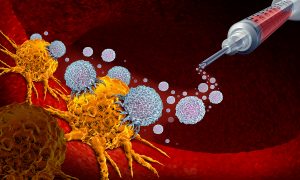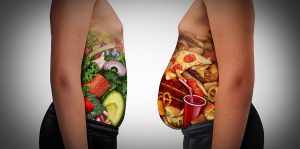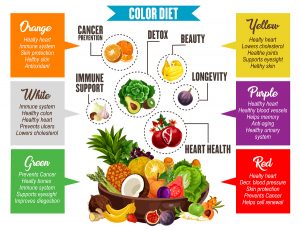In the first place, preliminary experiments indicate that the use of oncolytic viruses for cancer treatment may become a reality. There are several lines of research that point to the fact that oncolytic viruses can make a difference in treating incurable cancer patients.
Notably, Canadian researchers had reported in 2011 that oncolytic viruses created by genetically modifying smallpox vaccine viruses would enter tumor cells of patients, but not damage normal cells. Specifically, a high percentage of the end stage patients responded with tumor regression.
Shortly after Mayo Clinic physicians were desperate when two patients with end stage multiple myeloma, a vicious bone tumor, did not respond to chemotherapy. Significantly, they tried something unconventional: high doses of the measles vaccine in an attempt to stimulate the immune system. Here is an overview from 2014 that shows that many different cancers respond to various immunological approaches.
Study from Holland regarding end stage melanoma patients
Here is a small human study involving end-stage melanoma patients treated with the oncolytic virus T-VEC combined with pembrolizumab (Keytruda). It is important to realize that Keytruda helps to reactivate a T-cell response to the cancer cells. In this case the cancer cells absorb the oncolytic virus (T-VEC), but it leaves normal cells alone. Inside the cancer cells the oncolytic virus multiplies and destroys the cancer cells. In this 2017 study 21 patients with terminal, nonresectable melanoma received treatment with T-VEC and Keytruda. Specifically, 62% of the patients showed an objective response to the treatment. Moreover, 33% fulfilled the criteria of an immune-related response. In the past terminal patients like these had a 0% response to radiotherapy or chemotherapy.
History of research about oncolytic viruses
To begin with, in 1912 rabies virus treatment against cervical carcinoma was a first attempt to treat cancer. Researchers conducted many experiments between 1950 and 1970 with wild type or naturally attenuated viruses. This included, for example, hepatitis A and B viruses. In 1991 cancer researchers developed the concept of genetically engineered oncolytic viruses. Today cancer researchers know that the protection mechanisms in most cancer cells have deficiencies. This involves the interferon‐beta signal pathway. Having said this, there is an opportunity to let oncolytic viruses destroy cancer cells, while normal cells stay unaffected. An oncolytic virus that cancer experts use in human cancers is the genetically engineered herpes simplex virus type I (HSV‐1). Others that cancer researchers developed have strange names like T‐Vec, G47∆, JX594, CG0070 and Reolysin.
Various cancers that researchers treated with oncolytic viruses
Here are a few examples of cancers where researchers used oncolytic viruses to exert a significant therapeutic effect.
Glioblastoma
Glioblastoma is a deadly form of a brain tumor, which has a high rate of mortality. Researchers have investigated new avenues to treat this cancer. Researchers tested the genetically engineered dendritic vaccine. Initial clinical trials showed significant effectiveness compared to non-treated controls. In a large phase 3 clinical trial 331 patients with newly diagnosed glioblastoma received treatment at the time of neurosurgery with dendritic cell vaccine. 30.2% of the patients were still alive and doing well after 3 1/3 years. Without the added vaccination procedure all of these patients would have died in the past because of the aggressiveness of the glioblastoma.
Multiple myeloma
Researchers could cure multiple myeloma and other cancers by using the measles vaccine. Here is a report by the popular press about two women who had multiple myeloma. One woman got cured by high doses of a measles vaccine. The other women experienced some relief, but did not survive.
This publication explains that oncolytic viral therapy of cancer is a lot more complicated than originally thought.
Prostate cancer
Researchers found that vaccines against prostate cancer were effective with the combination of oncolytic virus therapy with regular anti-cancer treatments. But oncolytic virus therapy alone has a poorer prognosis than a combination of chemotherapy or radiotherapy with oncolytic virus therapy.
Cervical cancer
The high-risk HPV16 strain most often causes cervical cancer. The HPV (human papilloma virus) vaccine targets patients with previous exposure to HPV16. However, researchers have noticed that in some cases a phenomenon called the “HPV immune escape” has allowed in some vaccinated women to still develop cervical cancer. Now a group of researchers are investigating how the vaccine could be improved by finding out how the immune system is being tricked in these cases by the HPV virus to bypass the antibodies of the vaccine.
Pancreatic cancer
This cancer is very difficult to detect in the early stages, and as a result the outlook for chemotherapy or radiotherapy is extremely poor. Researchers have used several approaches as an alternative to conventional therapy. Immunotherapy is an option. Mayo clinic researchers have already announced that the measles vaccine approach will likely be applicable to pancreatic cancer treatment as well in the near future. However, other clinical trials are on the way to use alternative vaccination procedures.
Neuroblastoma, glioma and melanoma
This link shows that the FDA has accepted engineered oncolytic herpes virus (engineered to secrete GM-CSF) as a treatment against melanoma. Other approaches with engineered bacteria can affect neuroblastoma and glioma.
Survival data using oncolytic viruses for cancer treatment
Cancer researchers have completed a number of smaller clinical trials at this point. One of them describes end stage melanoma (stage III and IV) where the only treatment was with the oncolytic virus T‐Vec. The overall response rate compared to the control, which was only 5.7%, the experimental group with T-Vec was 26.4%. This is considered a good response rate given that we are dealing with end stage melanoma patients.
Mechanism of how oncolytic viruses stimulate the immune system to overcome various cancers
As mentioned above oncolytic viruses multiply in the cancer, once they have been incorporated. This leads to cancer cell death. It exposes the dead cancer tissue to the immune system. What helps in the process is that inhibitory proteins from the cancer cells that used to inhibit the immune system are no longer provided by the dead cancer cells. The end result is that the immune system mounts a formidable response against the cancer cells through killer T cells. This immune response also affects remote metastases of the same histological cancer type. This review article summarizes how oncolytic viruses work for cancer cell destruction and how this method can be combined with other treatment modalities.
Conclusion
Currently various cancer centers are involved with clinical trials in humans to test the power of oncolytic viruses. What cancer researchers have learnt is that oncolytic viruses are a useful tool to kill cancer cells. But the immune system of cancer patients is in a suppressed state. Pembrolizumab (Keytruda) is a medication that will stimulate the immune system by stimulating killer T cells to destroy cancer cells. The combined effect of killing cancer cells with oncolytic viruses and stimulating the immune system is the big news. This has been the breakthrough that cancer researchers have been waiting for. Now several clinical trials are on the way where survival rates for cancer patients given the new combination therapy are assessed.
Oncolytic virus therapy here to stay
It is a treatment which is no longer a thought model with animal experiments. Well known medical centers are using it in patients, and as the results become more obvious, it will very likely become a new treatment modality for cancer.















